Heraklion, Crete, Greece, 12 October 2018.
.
(Click on any image to see it in a larger size, if you are on a PC or tablet at least.)
.
This is a koulouras, from the West Court of the First “Palace” of Knossos, 2000 to 1700BC. It was used for storing grain and presumably had a cover, probably wooden, perhaps woven.
West Court.
Knossos was first excavated by Sir Arthur Evans, in the first two decades of the twentieth century. He named the Minoan civilisation after the legendary King Minos. If Minos actually existed, he was probably from an earlier period than the “Palace” of Knossos.
West Porch, Corridor of the Procession.
The West Porch (foreground) had a double door and led to the long Corridor of the Procession. That was named after a fresco on an adjoining wall showing a procession of people with gifts and also musicians.
There was a settlement at Knossos as early as 7,000BC. The first “palace” though, dates from around 2000BC. There were also other equivalent “palaces at various sites in Crete with the main other ones been at Phaestos, Malia and Khania. In this period the “palaces” had different styles so they were probably independent. Around 1700BC they were all destroyed by earthquakes and fire and the rebuilt. Knossos was rebuilt to a higher standard and the others now followed the Knossos style, indicating Knossos had now become dominant.
South House
This is from the New Palace Period of 1700 to 1450 BC, and reconstructed with three stories. Evans reconstructions are controversial as they are often based as much on imagination as evidence. A modern archaeologist would not duplicate his approach.
The Minoan civilisation survived tsunamis from the Thira eruption around 1550BC but that eruption and resulting climatic disturbance probably undermined it. The Mycenaeans from the mainland took over in 1450BC. There was widespread devastation at this time and subsequent rebuilding, though in a simpler style with less naturalistic art. The “palace” and outlying buildings were then destroyed by fire around 1300BC. There was little reconstruction after that and the site was abandoned by 1100BC, though it was later occupied by Greeks and Romans. The Cretans were not wiped out by the Mycenaeans because the distinctive pottery pithoi persisted and it is now believed there was a joint culture after 1450BC.
Same place, different viewpoint. Some may wonder at the hyper-realistic sculpture in the open doorway of a young woman in full colour and in modern dress with perhaps a brochure and wearing a wristwatch. It may be difficult at this distance to establish definitively if this is a creation of Evans or an unrestored original work of Minoan art.
The Minoan civilisation had a maritime culture with extensive trade and also colonies or partner states in Rhodes, Thira and the Cyclades. Knossos and the other “palaces” were not fortified, indicating a relatively peaceful society that was not threatened by external invasion. There were weapons and armour though and there was no doubt conflict at times between regional centres. There were also guard posts on main roads, indicating some existence of banditry.
Evans called Knossos and other centres palaces but it is by no means clear exactly how they operated. Functions may have included administration, trade, religion, politics and social activities.
.
Cup-Bearer Fresco, South Propylæum.
The South Propylæum was originally part of the Corridor of the Procession as shown in this fresco, related to the fresco of the procession mentioned earlier.
There was hieroglyphic script in the First Palatial Period and this was replaced after 1700BC by Linear A script, mainly on clay tablets. Neither of these have been deciphered and the language used is unknown. After 1450BC, there was Linear B script and the language was Greek.
Large pithoi (storage jars), South Propylæum, Postpalatial Period (1450-1100BC).
More is known of activities in Knossos after 1450BC due to writings in Linear B script which can be read. The was a leader called the Wanax and the administration was concerned with land tenure, religion and textiles. There were over 700 shepherds harvesting 50–75 tons of raw wool, woven by nearly 1,000 workers, and producing up to 20,000 textile items. It is not known whether this may have differed before theMycenaeans took over in 1450BC.
Piano Nobile.
The piano nobile is largely Evan’s creation. He thought there would be first floor reception rooms like in a Italian Renaissance palazzo. In the background it the Central Court, where bull-jumping and other activities would have occurred. (I did not think to photograph this more directly).
Bases of columns near the West Magazines, long narrow spaces for storing pithoi.
Les Parisiennes.
When an early archaeologist saw this fresco, impressed by the sophistication of their attire, he exclaimes “But these are les Parisiennes!”. (Sorry about the reflections).
We now see a succession of frescoes from the Hall of the Fresco Copies. So these are not the originals, held in controlled environments in museums. I presume that the originals, usually fragmentary, would have been found in various locations in Knossos.
What is known of Minoan art and religion indicate it was a culture with a much more prominent role for women than later cultures. It is not known whether it was a matriarchal culture but one aspect must have been men going off in ships to trade and leaving women with a large role in running the homeland.
The Bull-Jumping Fresco.
A feature of Minoan culture was bull-jumping, an initiation ritual for young men. The bull would presumably be charging at them and their task was to grab the horns, somersault over the bull and be caught by attendants.
. .
.
The fresco represents an octopus, it’s recreated from fragments (as you can see if you click on it for a larger view and look carefully) and the original is 3,500 years old or more but it could almost be modern art.
This is nearby the Hall of the Fresco Copies, but I’m not sure exactly where.
This shows something of the context.
.
Prince of the Lillies Fresco.
This is a very fragmentary reconstruction by Evans at the South Entrance. There are various opinions as to how it should appear.
A set of stairs, now seemingly into the void.
This is the North Entrance, seen from the side.
Moving around, the actual entrance was just to the right.
… and here is a closer view of what remains of the fresco.
This is The Throne Room.
A slightly different viewpoint.
And the “throne”.
This is a wooden copy of a stone “throne” from an adjoining room. The purpose of the room is unknown. It may have been used for religious ceremonies but was unlikely to have been a throne room in the modern sense.
Shrine of the Double Axes.
A stone double axe and votive clay offerings were fond here.
Outside The Hall of Double Axes.
This was named by Evans after double axe signs carved into the walls of the lightwell at the rear. Evans thought it was the King’s residence.
Inside The Queen’s Megaron.
A richly decorated room that Evans though must have belonged to the Queen. A small side-room is named the Queen’s bathroom due to ceramic fragments that he thought were remains of a bath.
Outside The Queen’s Megaron.
Pithoi from The Magazines of the Giant Pithoi.
Pithoi from the Corridor of the Bays.
.
North Lustral Basin
This leads down to a room at a lower level than the rest of Knossos that Evans thought was something like a cistern, used for purification ceremonies. However, it is unlikely that there was water here and its purpose is unknown.
Theatral Area.
This reminded Evans of later Greek theatres and he thought this may have been used for performances viewed by a standing crowd.
The Royal Road.
So-named by Evans with his usual royalist preoccupation. It continues on (under the modern road) to the Minoan town that eventually became Heraklion.
References:
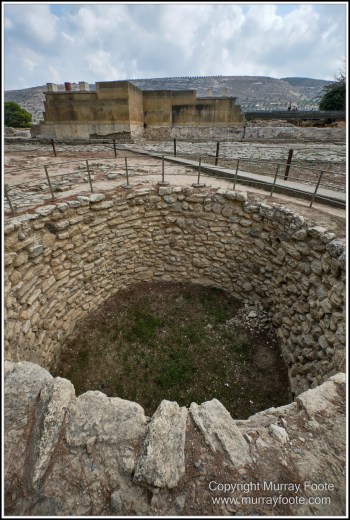
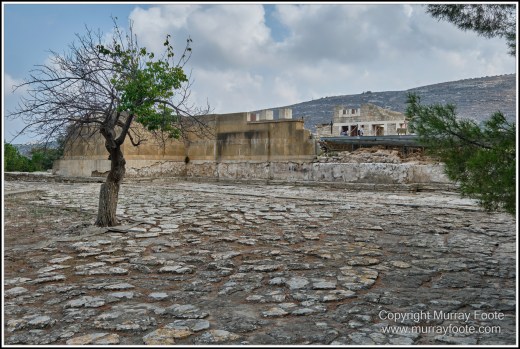
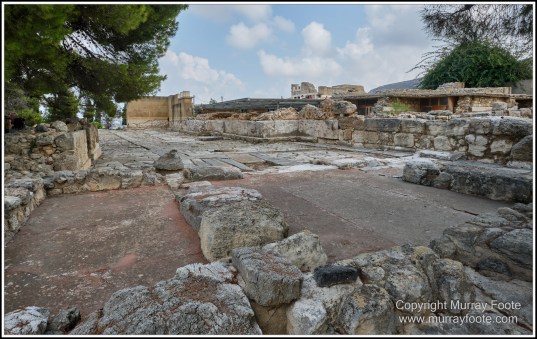
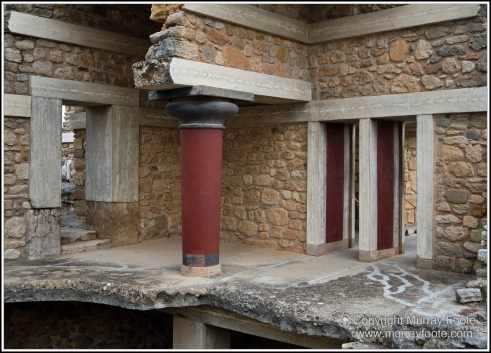

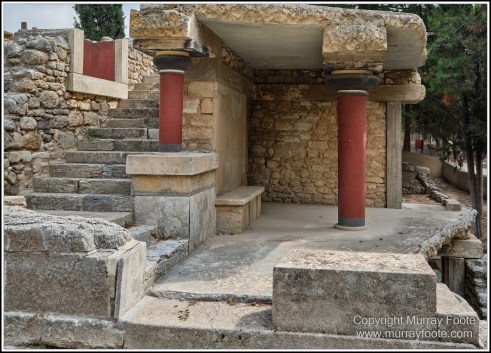
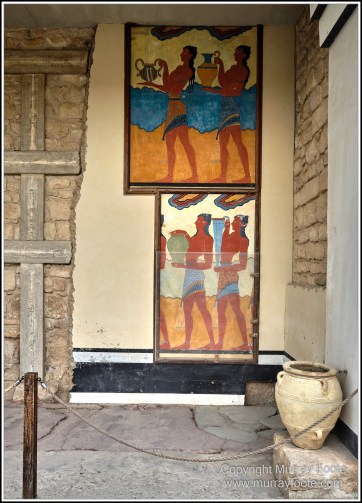
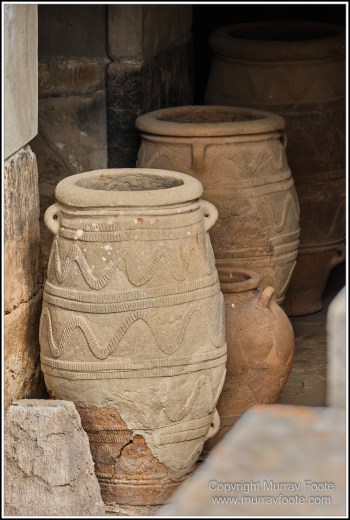
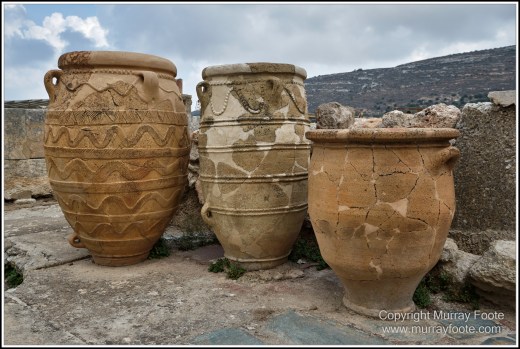

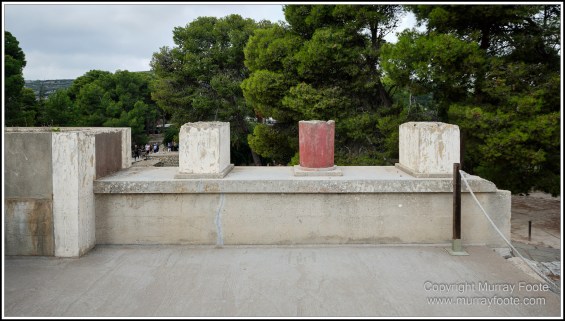


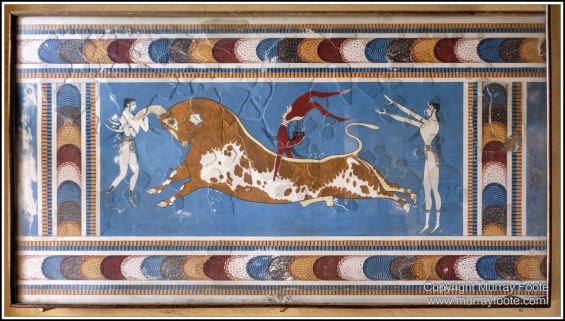

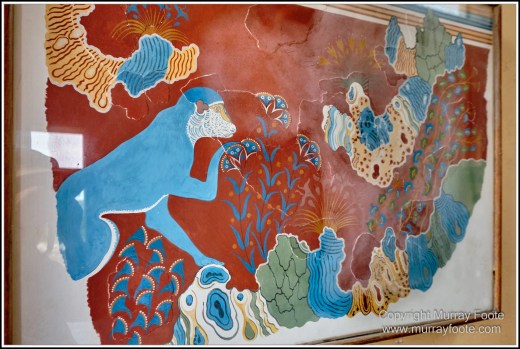
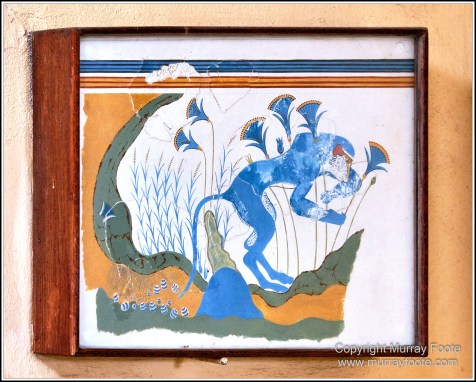
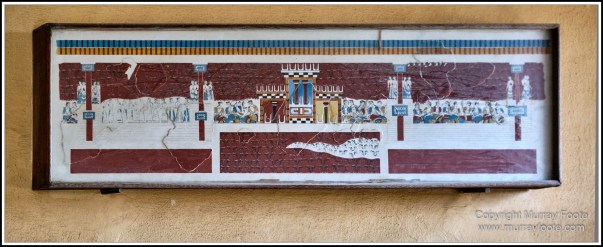
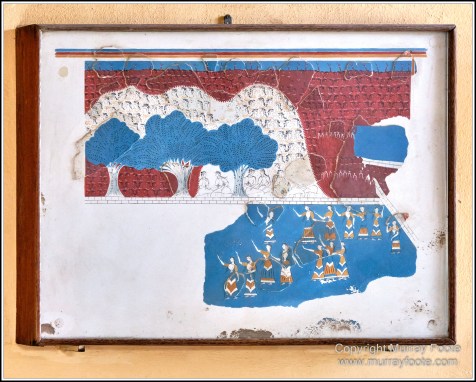
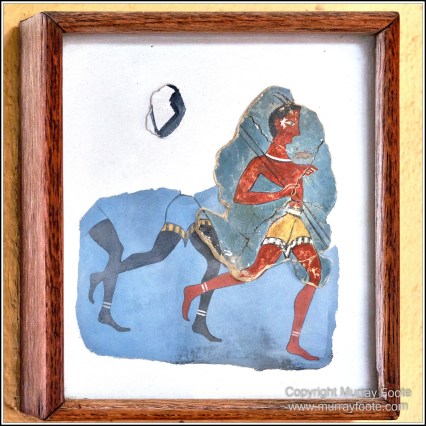

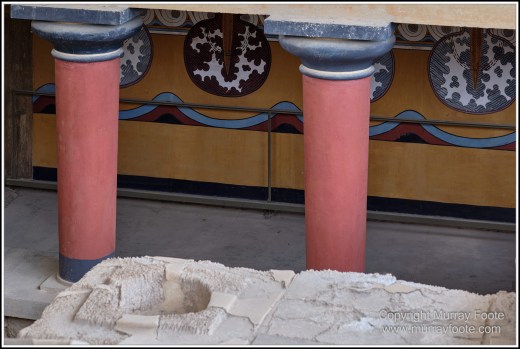
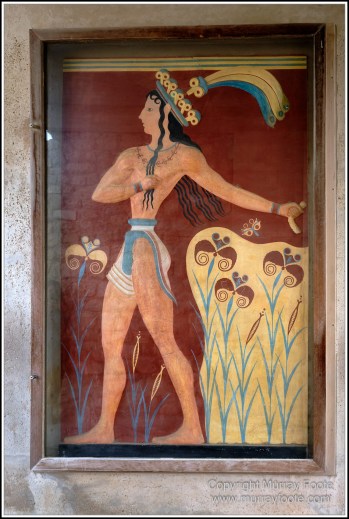
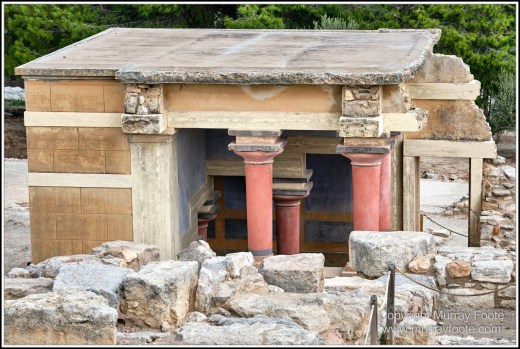
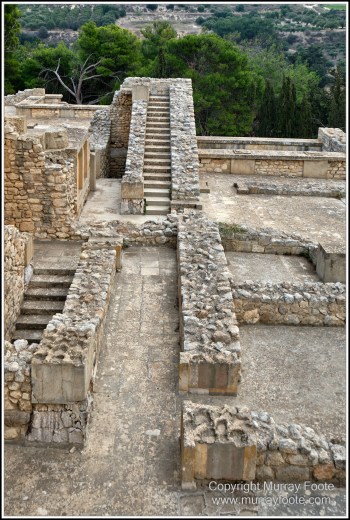
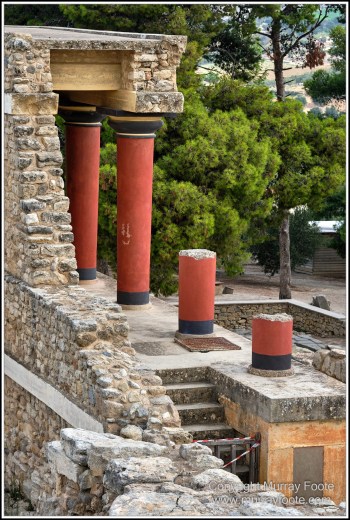
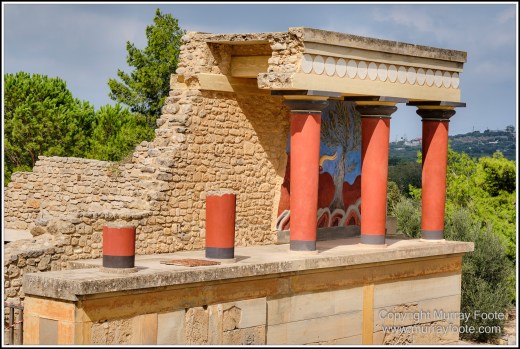

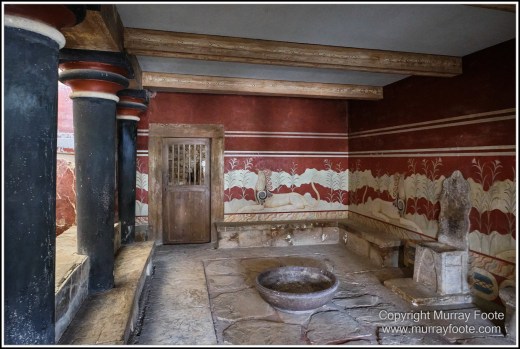


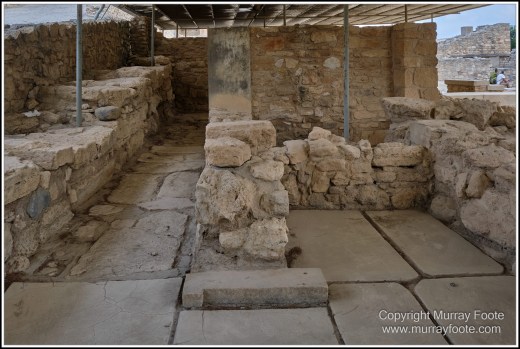
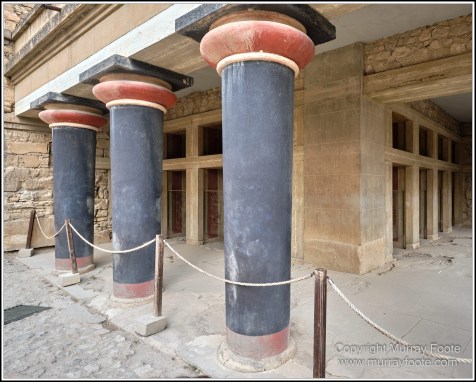

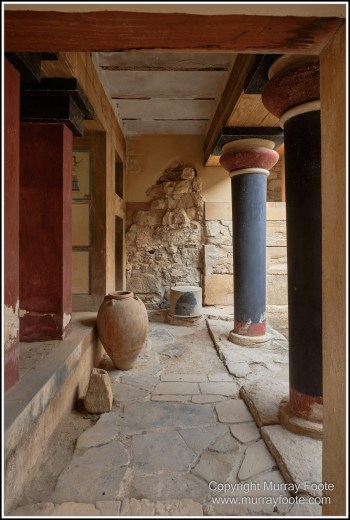
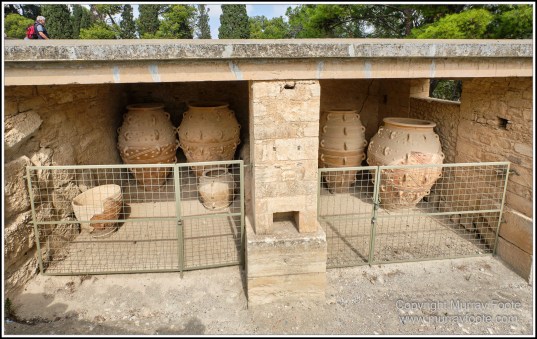
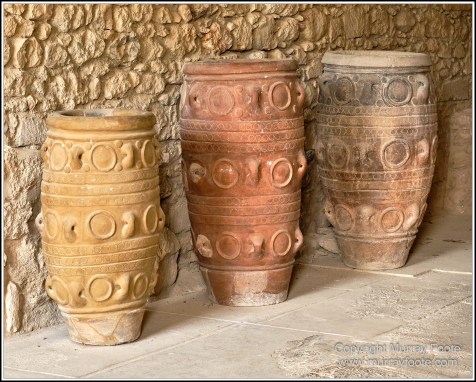
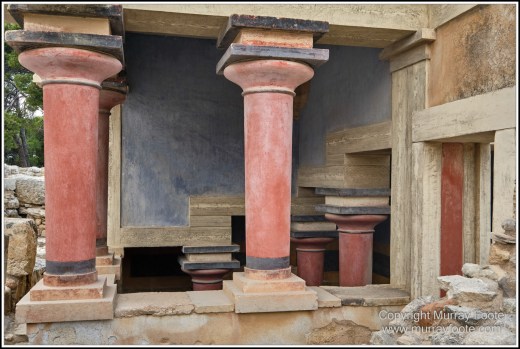
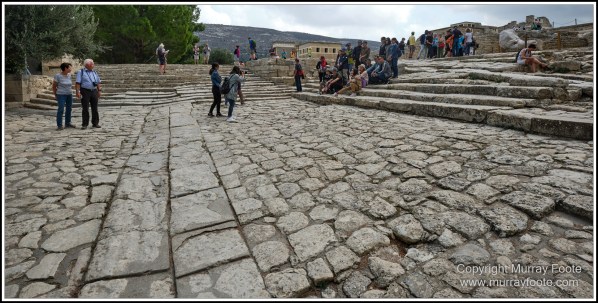
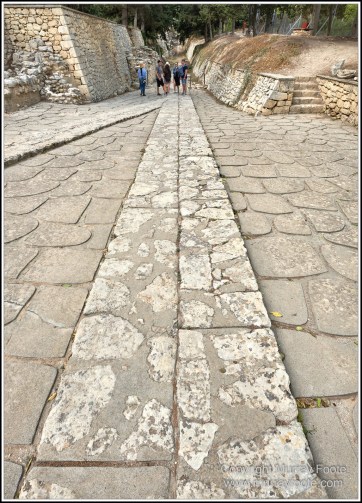
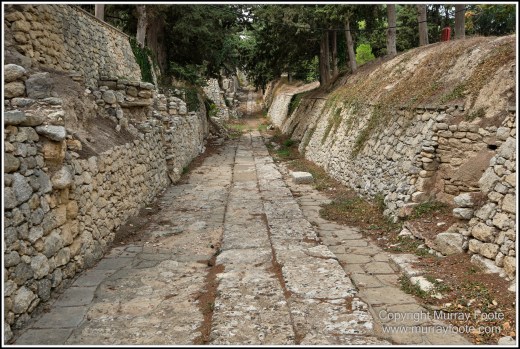
They certainly made an art form of working with stone.
LikeLiked by 1 person
It must have been a mind-blowing place at the time.
LikeLiked by 2 people
The frescoes are just magnificent! Thanks for sharing!
LikeLiked by 2 people
Thanks very much Anna! More frescos in the next post of the Archaeological Museum.
LikeLiked by 2 people
Pingback: Uzbekistan, Crete, Spain and Oregon Itinerary « Murray Foote
Pingback: Monochromes from Eastern Crete « Murray Foote